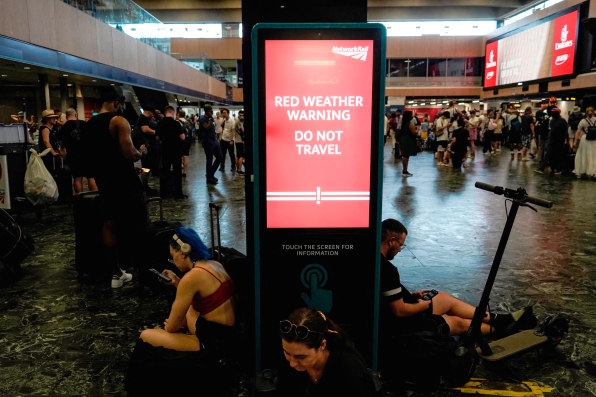The U.K.’s infrastructure wasn’t designed for this brutal heat. Here’s where it’s most likely to fail
Hot weather strains the pipes that pump our water, the power lines that deliver our energy, and the roads and railways that get us home at night. As global temperatures continue to rise, national infrastructure will be challenged as never before.
Climate change is intensifying heat waves in the U.K., an affluent country with the capacity and resources to adapt to warmer temperatures. Still, very little has been done over the past 10 years to address overheating in buildings and the rising risk to critical infrastructure. The country is unprepared to handle temperatures of more than 38 degrees Celcius (100.4 degrees Fahrenheit) consistently for long periods, which is more common in Mediterranean countries.
U.K. infrastructure has typically been designed to retain heat during the winter, but it must become effective at keeping the heat out in the summer. As things stand, roughly 20% of existing U.K. infrastructure is at risk of overheating—and this threat is projected to rise as average temperatures climb.
Rail
Railways across the U.K. contain thousands of miles of steel track. Steel has a high thermal conductivity, which means it can absorb and transfer a lot of heat faster than other construction materials, and reach up to 20 degrees Celsius hotter than the surrounding air temperature. Steel rails lengthen in the heat, pushing against the base and sides of the track. When there is no room to expand the rail can buckle, which takes a few days to repair and necessitates significant delays.
In hotter European countries, including Spain and France, the steel used in rail lines is typically treated differently before and during manufacture. For instance, different alloys may be used, or the steel may be fabricated differently so that it can release heat stress more effectively once deployed.

[Photo: Niklas Halle’n/AFP/Getty Images]
About 40% of the British rail network is electrified, using both overhead lines and conductor rails. Power lines can sag in hot weather, so trains are ordered to travel at much slower speeds to prevent electrical fires. Slow journeys exert less force too, making it less likely the track will buckle.
Thankfully, modern overhead lines are less affected by hot weather as they contain auto-tension systems with springs or balance weights that adjust to varying temperatures. Older overhead power lines still contain fixed tension connectors to the trains and are much more vulnerable to failure during heat waves; these must be replaced to prepare the U.K.’s rail network for hotter summers in the future.
Water
Water pipes don’t just burst or fracture during the colder months of the year. As households consume more water during hot weather, water pressure in underground pipes rises. Meanwhile, parched soil can become loose and dry, allowing room for water pipes to shift, particularly the bends, joints, and connectors. When combined with high temperatures and UV rays on exposed parts of the network, pipes may burst.
Poorly maintained water pipes struggle to withstand long periods of hot temperatures, fluctuating pressure loads, and inconsistent rainfall. Weak spots in pipelines are usually covered and insulated with polyethylene, a flexible plastic foam insulator.
This ensures damage from overheating is limited, but additional research is needed to make water utilities more resilient. In the meantime, the U.K. could extend the lifetime of its pipes by wrapping weak points more frequently and expanding the layer of protective material elsewhere.
Electricity
Hot weather can cause big problems for the networks that generate and distribute electricity. Power transmission cables in the U.K. are often clad in aluminum or rubber, materials that are susceptible to expanding in the heat.
Pylons are typically encased in glass and ceramic—better insulators that prevent the structures from conducting electricity. These are too expensive to coat vast lengths of transmission cables, though. Power utilities will need to research alternative materials to help wires and electricity flexes withstand higher temperature variations.
The U.K. could also install conductors capable of working in hotter conditions and build taller power line poles.
Similar to the transmission cables for trains, electrical power lines expand and slacken in extreme temperatures, increasing resistance and lowering how efficiently the entire system distributes energy. A severe drop in efficiency can shut down power plants and plunge people trying to keep cool into a blackout.
Building a net-zero country demands not only transitioning to zero-carbon technologies but also adapting existing infrastructure to withstand the challenges of climate change. An economy capable of slowing and eventually reversing global heating can emerge only if we adapt what already exists to the inevitable impacts to come.
Kiran Tota-Maharaj is a reader in civil and environmental engineering at Aston University.
This article is republished from The Conversation under a Creative Commons license. Read the original article.
(40)


